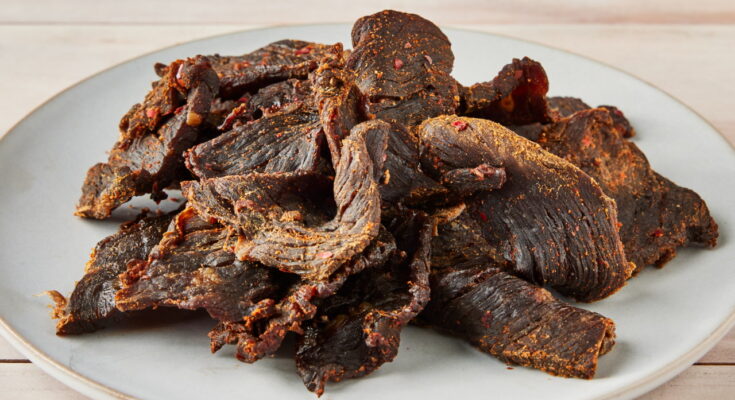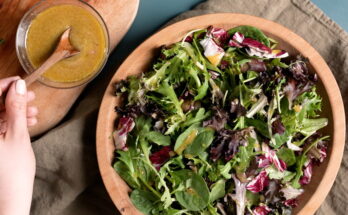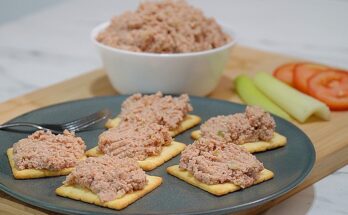Beef Jerky Marinade Recipe: Beef jerky has been a favorite snack for centuries, thanks to its long shelf life, portability, and rich flavor. It’s essentially lean strips of beef that have been marinated, seasoned, and dried until chewy. What makes jerky truly delicious is the marinade—the blend of spices, sauces, and seasonings that infuses the meat with deep flavor before the drying process. Without a proper marinade, beef jerky would be bland and tough.
In this guide, we’ll break down everything you need to know about making the perfect beef jerky marinade, from the essential ingredients to step-by-step instructions. By the end, you’ll be ready to whip up a homemade batch that tastes better than anything you can buy at the store.
Essential Ingredients for Beef Jerky Marinade
When it comes to making beef jerky, the marinade is where all the magic happens. You don’t need fancy ingredients to start, but having the right balance of salty, sweet, and savory flavors will make all the difference. Let’s break down the basics:
List of Basic Ingredients
Most classic beef jerky marinades include these staples:
- Soy Sauce – the salty backbone of your marinade.
- Worcestershire Sauce – adds depth and umami.
- Brown Sugar or Honey – for sweetness and balance.
- Black Pepper – sharp and spicy kick.
- Garlic Powder & Onion Powder – aromatic flavor.
- Liquid Smoke (optional) – gives that smoky BBQ vibe.
These ingredients form a solid foundation. From here, you can customize your marinade to your liking.
Optional Add-ons for Extra Flavor
Want to elevate your beef jerky? Try experimenting with:
- Crushed Red Pepper Flakes – for extra heat.
- Ginger – gives an Asian-inspired flavor.
- Cayenne Pepper – spicy lovers’ favorite.
- Apple Cider Vinegar – adds tang and helps tenderize.
- Maple Syrup – for a sweet, smoky twist.
Remember, the beauty of homemade jerky is flexibility—you get to decide how mild or bold the flavors should be.
Choosing the Right Cut of Beef
The cut of beef is just as important as the marinade. Always go for lean cuts since fat doesn’t dry well and can cause spoilage. The most popular choices include:
- Top Round
- Bottom Round
- Sirloin Tip
- Eye of Round
- Flank Steak
Slice the beef thinly (about 1/4 inch thick) for quicker drying and better marinade absorption. Pro tip: partially freezing the beef makes slicing easier and more precise.
Tools and Equipment You’ll Need
Before diving into the process, make sure you have the right tools. You don’t need a professional kitchen setup—just some simple equipment will do.
Kitchen Essentials
- A sharp knife or meat slicer for even cuts.
- A large mixing bowl to combine your marinade.
- Measuring cups and spoons for accuracy.
Storage Containers for Marinade
After mixing your marinade, you’ll need to soak the beef properly. Use:
- Ziploc bags – convenient for marinating in the fridge.
- Glass containers with lids – non-reactive and eco-friendly.
Dehydrator vs Oven – Which One to Use?
Drying is the final stage of jerky-making, and you’ve got two options:
- Dehydrator – designed specifically for jerky, giving even results with adjustable temperature.
- Oven – works just as well if set to a low temperature (around 160°F/70°C) with the door slightly open to let moisture escape.
While a dehydrator is easier, don’t stress if you don’t have one. Your oven can produce fantastic results too.
Step-by-Step Guide to Making Beef Jerky Marinade
Now that we’ve covered the essentials, let’s get into the exciting part: the actual process. Making beef jerky is simple but requires patience, especially during the marinating and drying stages.
Step 1 – Preparing the Beef
Start with lean cuts and trim off any visible fat. Freeze the beef slightly for about 1 hour—it makes slicing much easier. Cut against the grain for a tender chew or with the grain if you prefer a tougher bite. Make sure the strips are uniform in thickness to ensure even drying.
Step 2 – Mixing the Marinade
Combine soy sauce, Worcestershire sauce, sugar, and spices in a large bowl. Whisk until the sugar dissolves completely. Adjust the seasonings based on taste—spicy lovers may add cayenne, while sweet fans might increase honey or maple syrup.
At this point, taste-testing is crucial (just the marinade, not the raw beef!). The flavor should be slightly stronger than you’d normally like since it will mellow out during drying.
Step 3 – Marinating the Beef
Place the sliced beef into a bag or container and pour the marinade over it. Massage the meat gently to make sure all pieces are coated. Refrigerate for at least 6 hours, though overnight is best for maximum flavor. Turn the bag occasionally to keep the marinade evenly distributed.
Step 4 – Drying and Dehydrating
Once your beef has fully absorbed the marinade, it’s time for the drying stage. This is where your jerky develops that signature chewy texture. Start by removing the beef from the marinade and patting each strip dry with paper towels. This step is important—excess liquid will slow down the drying process and can lead to uneven results.
Next, arrange the strips in a single layer on dehydrator trays or oven racks. Make sure none of the pieces are overlapping, as this prevents proper airflow and can leave parts of your jerky undercooked. If using a dehydrator, set the temperature to around 160°F (70°C) and let it run for 4–6 hours. In an oven, preheat to the same temperature and keep the door slightly open with a wooden spoon to allow moisture to escape. Drying time in the oven usually ranges from 3–5 hours, depending on the thickness of the strips.
You’ll know your jerky is ready when it’s firm but still pliable. Bend a piece—if it cracks slightly without breaking in half, it’s perfect. If it snaps, it’s overdone and too dry. Remember, jerky continues to firm up a little as it cools, so don’t worry if it feels slightly soft when you first remove it.
Step 5 – Storing Your Homemade Beef Jerky
Proper storage is key to keeping your jerky fresh and flavorful. Since homemade jerky doesn’t contain preservatives, it won’t last as long as store-bought varieties unless stored correctly.
For short-term storage (up to a week), keep jerky in an airtight container or resealable bag at room temperature. For medium storage (up to a month), refrigerate it in a sealed container. For long-term storage (up to 3 months or more), vacuum-seal your jerky and store it in the freezer.
If you’re planning to carry jerky for camping or hiking trips, portion it into small bags to avoid opening and exposing the whole batch repeatedly. Always check for signs of spoilage—such as unusual smells, mold, or sliminess—before eating. A little extra care goes a long way in ensuring your jerky stays safe and tasty.
Tips and Tricks for Perfect Beef Jerky
Making jerky is part art, part science. While the process is simple, a few insider tricks can elevate your results dramatically.
Common Mistakes to Avoid
- Skipping the fat trimming – fat can spoil quickly and ruin your batch.
- Cutting uneven strips – leads to some pieces over-drying while others remain underdone.
- Over-marinating – too much time in the marinade can make the jerky overly salty or mushy.
- Not drying thoroughly – moisture left in the jerky can cause mold growth.
How Long Should You Marinate?
The sweet spot is 12–24 hours. Less than that, and your beef won’t fully absorb the flavors. More than 36 hours, and the meat may become overly salty.
Adjusting Marinade for Taste and Texture
Don’t be afraid to experiment. Love spice? Add more chili flakes. Want a smoky BBQ vibe? Increase the liquid smoke. Prefer sweeter jerky? Use maple syrup instead of sugar. The key is balance—too much of one flavor can overwhelm the meat. Always taste your marinade before adding the beef.
Flavor Variations for Beef Jerky Marinade
One of the best parts about making beef jerky at home is the freedom to create unique flavors. Here are some tried-and-true variations you can try:
Sweet and Spicy Jerky
Combine honey, soy sauce, red pepper flakes, and cayenne pepper. This version hits you with sweetness first, followed by a slow, spicy burn.
Teriyaki Style Jerky
Mix soy sauce, brown sugar, garlic, ginger, and sesame oil. This gives your jerky a deliciously Asian-inspired flavor that’s both savory and slightly sweet.
Smoky BBQ Jerky
Use Worcestershire sauce, paprika, liquid smoke, and a touch of molasses. It’s like enjoying barbecue on the go without firing up the grill.
Garlic and Herb Jerky
Marinate beef in soy sauce, olive oil, minced garlic, thyme, and rosemary. This creates a fragrant, savory jerky that feels more gourmet than snack food.
These variations can be tailored to your taste preferences, so don’t hesitate to mix and match ingredients until you land on your signature jerky recipe.
Health Benefits of Homemade Beef Jerky
Beef jerky isn’t just a tasty snack—it also comes with several nutritional benefits, especially when you make it at home. Unlike store-bought jerky, which often contains preservatives, artificial flavors, and excess sodium, homemade beef jerky allows you to control every ingredient that goes into it.
Protein Packed Snack
Beef jerky is a powerhouse of protein. A single serving can provide up to 10–15 grams of protein, making it an excellent choice for athletes, fitness enthusiasts, or anyone who needs an energy boost during the day. Protein helps build and repair muscles, keeps you feeling full for longer, and stabilizes blood sugar levels.
Low-Carb and Keto-Friendly
If you’re following a low-carb or keto diet, beef jerky is the perfect snack. Since it’s made primarily of lean beef with seasonings, it contains very little sugar or carbs—especially if you avoid sweet marinades. Pair it with nuts or cheese for a satisfying keto-friendly snack.
Preservative-Free and Natural
When you prepare jerky at home, you avoid harmful additives and excessive salt found in many commercial brands. You also get the peace of mind that comes with knowing your jerky is fresh, natural, and tailored to your dietary needs. By using quality cuts of beef and fresh seasonings, you’re essentially creating a nutritious, clean-label snack that’s both delicious and healthy.
Serving Ideas for Beef Jerky
Beef jerky is versatile—it’s not just for road trips or emergency snacks. There are plenty of creative ways to enjoy it beyond munching straight from the bag.
On-the-Go Snack
Jerky is lightweight, portable, and doesn’t require refrigeration, making it the ultimate grab-and-go snack. Keep a bag in your car, office desk, or gym bag for a quick protein boost anytime.
Camping and Hiking Food
Outdoor enthusiasts love jerky because it’s non-perishable and packed with energy. Whether you’re hiking through the mountains or camping under the stars, beef jerky keeps hunger at bay without weighing down your backpack.
Pairing with Drinks
Jerky pairs surprisingly well with drinks. Try enjoying smoky jerky with a cold beer, sweet teriyaki jerky with a light white wine, or spicy jerky with a refreshing cocktail. It also makes a fantastic charcuterie board addition when paired with cheese, nuts, and dried fruits.
You can even chop jerky into small bits and use it as a topping for salads, baked potatoes, or omelets. Think of it as a savory, high-protein alternative to bacon bits.
FAQs about Beef Jerky Marinade Recipe
1. Can I use chicken or turkey instead of beef?
Yes! Chicken and turkey can both be used to make jerky, though you’ll need to adjust the drying time since poultry cooks faster. Always ensure it reaches a safe internal temperature to avoid foodborne illness.
2. How long does homemade beef jerky last?
At room temperature, it lasts about 1 week if stored in an airtight container. In the fridge, it can last up to 1 month, and in the freezer, up to 3–6 months if vacuum-sealed.
3. Can I freeze beef jerky?
Absolutely. Freezing is the best way to extend jerky’s shelf life. Just make sure it’s sealed tightly to prevent freezer burn.
4. Do I need a dehydrator?
Not necessarily. While a dehydrator makes the process easier and more consistent, you can still make excellent jerky in your oven or even an air fryer with a dehydration setting.
5. What’s the best beef cut for jerky?
Lean cuts are ideal. Popular choices include top round, bottom round, eye of round, and flank steak. These cuts are flavorful, affordable, and low in fat, making them perfect for drying.
Conclusion
Whether you prefer sweet and spicy, smoky BBQ, or a classic savory blend, homemade beef jerky guarantees freshness, flavor, and health benefits. Plus, it’s a versatile snack—perfect for road trips, workouts, camping adventures, or even as a gourmet pairing with drinks.
So why settle for store-bought when you can make jerky exactly the way you like it? Grab some beef, mix up a marinade, and start your jerky-making journey today—you’ll never go back to packaged jerky again!



